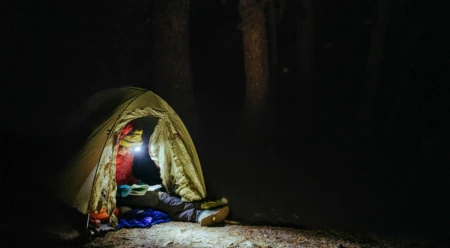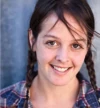FFFKT (Fastest Fish Fourteener Known Time)
Jenn Shelton traverses the Sierra High Route.
I picked it up on a whim at the ranger station in Bishop 2012. I was there finagling a permit that would look more or less legal for my attempt to break the men’s speed record across the John Muir Trail starting the next day. And there it was in my hand, the same way a plastic $20 Timex watch had been on my wrist since I started running in high school. One day it wasn’t there and then one day it was, part of me forever.
I’m not sure why it called to me, as I had no intention of reading it then. The next four summers of my life would be consumed with the JMT. I’m also not one to spend $17 on a book, especially not a guidebook that I knew would sit on a shelf. Books are objects of motion, not acquisition. They are for lending, trading, sharing, discussing. Destroying from a life well-lived. The cover is unremarkable: Sierra High Route: Traversing Timberline Country, Second Edition, Steve Roper.
The title is printed over a photo that refuses to catch your eye. The photo isn’t out of focus or poorly composed, it just lacks a certain sharpness, as if taken by a person with horrible eyesight.
You see a wind-ravaged tree, right of center, which adheres to the rule of thirds. And some rocks, not big enough to be boulders, not flat enough for sitting. The background (a generous term as the photo has about as much depth as a sardine tin) suggests a blurred mountain skyline. It captures more the experience of spotting the back of a whale than the feeling of gazing upon the jagged towers of the Minarets, which I know those mountains to be.
And if all that isn’t insult enough. Above the mountain, there’s the sky.
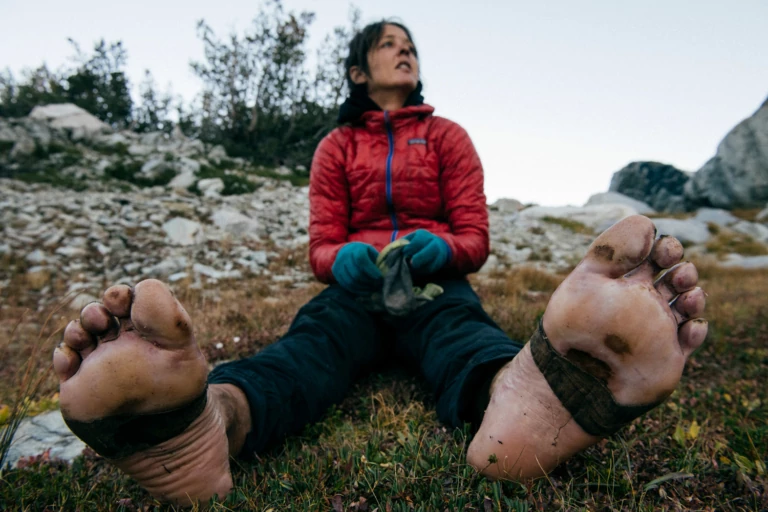
I brought one pair of socks. This was not a horrible idea until about day nine, which was when it became one of my only lifes regrets. That, and going to college. Photo: Ken Etzel
In the photo it is a cloudy, ocean grey. For anyone who has spent any time in the Sierra, which John Muir affectionately nicknamed “The Range of Light,” this mucky sky is not the version they remember, let alone the version they would choose for the cover of a book. The white-hot Sierra Nevada sky is not, like the book cover suggests, a lady of understatement. She is a ham, a ballbuster, a town crier. She starts the day shouting in oppressive blue, and by 10 a.m. she is a dangerous flirt, puffing her chest with fast-swelling cumulus. Most days she is just toying with you. But when she decides to open up—which she supposedly does less often than any mountain range of her size—she makes up for all her harmless foreplay by unleashing storms so dark and furious that they can only be described with one word: horrific.
I have never weathered summer storms as bad as the ones I have somehow survived while traveling in the Sierra.
But the cover of the book is a bored purgatory of neither glorious day nor howling storm. In a world of “Look at me, look at me!” the second edition of Steve Roper’s Sierra High Route is silently praying that you pass over it. Or under it, on the wildly popular JMT, as most but a handful of people thankfully do each year.
In the summer of 2018, I decided to be among that handful.
Things weren’t going well. In truth, they hadn’t been going well for a while. I’d dumped my boyfriend, who loved me but not every single last one of my imperfections, and bought a van, which seemed like the sexy thing to do at the time. Except the van was not one of the sexy vans you see when you think of “living the dream.” It was tiny. It looked and handled like a toaster on wheels. I broke my leg. Twice.
Usually, I need a little chaos to thrive. It’s how I carved a career out of running 100-mile races—because they were unpredictable. I grew up listening to punk music. One friend nicknamed me “Jenntropy,” a play on the fundamental rule of the universe: It always takes less energy to destroy something than to build it. That chaos, not order, is how all systems lean. Although in these last years, it felt like I’d leaned too far.
But I’d never thought about quitting before. It had been a year and a half since the accident that broke my leg a second time, and I could run for about five minutes. Then the pain was too much. All the mind-numbing hours of physical therapy, of retraining my muscles how to walk, had done nothing.
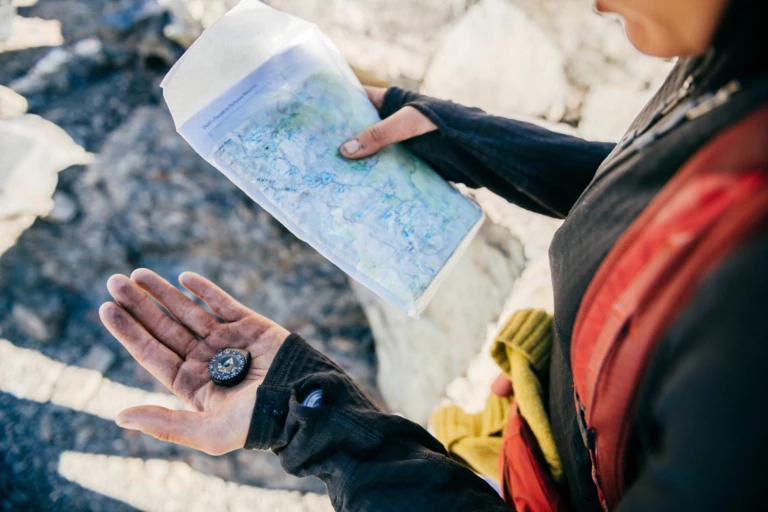
People who ask me if I calibrated my compass don t get it. Calibration is useless when the directions are head east for a while. Photo: Ken Etzel
I texted my best friend, the one who was with me when I crashed. The one who called the rescue and also looked the rescuers in the face and told them that I wasn’t leaving my skis behind. Who visited me every day in the hospital and then gave me a bed in her home to heal.
“I think it’s time to throw in the towel.”
She responded immediately, as if she’d been ready for this since she’d found me in a pile in the snow.
“You fought hard. It’s ok.”
“Maybe I’ll get a real job.”
Silence.
“If I work a 9-to-5, I think I will be dead in a year.” After pressing send, I dropped my phone onto the floor of my van. My old self would have thrown the phone into the woods. My old self would have screamed, punched something, cried, drank a beer or five. My old self could run 100 miles in under 15 hours, made her living off running farther and faster than pretty much anyone alive. She was a bad ass, but she was also kind of an ass.
The best part of breaking myself as badly as I had is that I had to let go of everything. There were the first three months in bed. Friends warned me that with an injury of that magnitude, I would go through all the stages of depression. The cheerier friends told me I would finally have time to write a book. One friend told me that I would finally realize that I was a lesbian. I was prepared for anything.
But every day I woke up and things were fine. I was shocked. I’d look over my shoulder expecting to see a dark cloud approaching. But there was nothing there. Just the white wall of my friend’s spare bedroom. And something I had never felt before. A quiet calm. I spent the days breathing. I know I was supposed to be doing something productive. But breathing seemed like plenty.
My phone buzzed, breaking the silence. “You’d be dead by the first Friday.”
That night, the night I quit running, I opened the book. It was that or get a job. For three years, I’d carted it around. Inexplicably, out of the hundreds of books I owned, it was the only one I kept. My imaginary friendship with Roper started then.
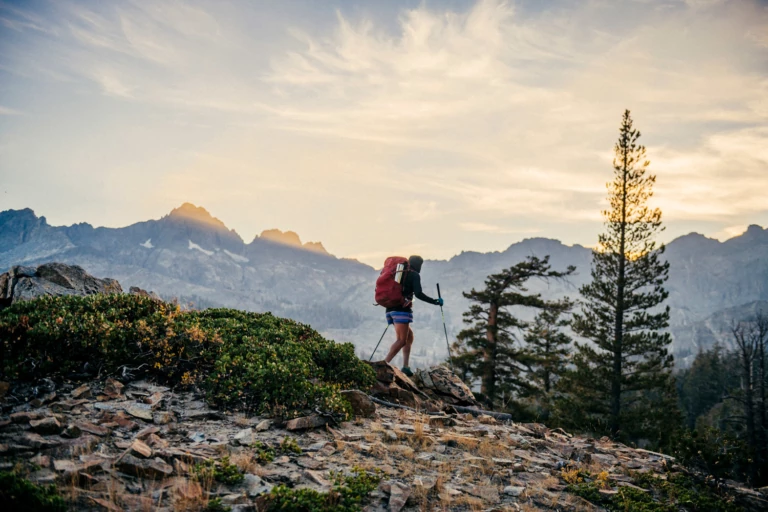
Each section of the book has a list of peaks to bag, called “mountaineering options.” I decided I wanted the women’s fkt to be more well rounded than the men’s. I decided I’d set the precedent. I climbed a fourteener and caught a fish in all five sections-FFFKT. Photo: Ken Etzel
The Sierra High Route breaks down into something like this:
The Start: Roads End Campground, on the high-desert western flanks of the mountain range; closest city is Fresno.
The What: Follow the Sierra crest, undulating from tree line to alpine; avoid dropping into the valleys whenever possible.
The Length: Around 195 miles with 59,000 feet of climbing.
The Objective: Cross all 34 mountain passes, mostly unnamed on maps (in some cases Roper has given these passes his own name).
The Difficulty: A boulder-jumping, scree-sliding, scrambling trek with no ropes or rock climbing skills necessary, unless you are three feet off route, in which case things get spicier.
The Actual Difficulty: Roper does not provide a line on a map to follow. The High Router is supposed to stand on a mountain pass, and read a vague description of how to most safely descend it. The High Router should also try to figure out, from Roper’s written descriptions, which of the dozens of mountain passes seen in the distance she should aim for next.
The Best Part: The Delusional Roper Friendship. Following Roper’s written descriptions to go from point A to point B is the lifeline for every High Router. Everyone forms a relationship with Roper, referring to him as a capitalized He. As in, “I wish He would have stopped waxing poetic about the stag He saw one time in that fucking meadow and would have given a rat’s ass that I needed to contour left to avoid getting marooned in some Class 4 slab deathtrap. But otherwise His descriptions were beefy today compared to yesterday.” This relationship is a constant rotation through sentiments of ecstatic fondness, irritation and varying degrees Stockholm Syndrome.
The Usual: It is estimated that about 10 people do the entire route each year. The route is divided into five sections. Upwards of fifty people complete one section each summer, averaging about a week for each section. It is common to go days without seeing another human.
The Finish: A popular redneck camping area called Mono Village on the northwest boundary of Yosemite, where the trekker can purchase such kingly rewards as malt liquor, Pringles and a gray-tinted banana.
I was sold.
I’m not sure what the opposite of lonely is. Is there a language where a word for this exists? I’ve thought about this a lot. The closest definition I’ve been able to come up with, is that feeling inside you when all the spaces are filled. The mountains have always made me feel this way. Bed rest made me feel this way. Nothing else ever has.
I liked Roper, and I wanted Roper to like me. Here was a man who wrote an entire book about how to cross a mountain range, while providing as little practical information as possible about where to actually go. He’d tell you to cross a river at the bottom of a valley, and then to reach your next mountain pass, miles of trail-less travel away, he’d say things like, “Head in an easterly direction, eventually aiming for a reddish band of cliffs.” But when it came to useless information, he was more forthcoming. Like the stag example. Or, he’d offer a full page to tell you about his favorite tree, the whitebark pine.
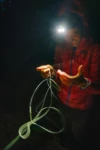
I didn’t have the stomach to bash a fish head, so the first three fish I decided to kill all managed to flop their way back into the lake. Fish can flop a long way back to water. I was impressed. Photo: Ken Etzel
In his defense, it is a fascinating tree. It grows short, squat and gnarled in the high alpine. Sometimes it seems to grow right out of granite rock. Roper is quick to tell his readers that John Muir would sleep on its fallen needles, claiming them superior to any sleeping pad or mattress provided by the industrial world. Which could be good information, because, by following Roper’s scant directions, his readers are certain to spend more than a few nights stranded in an alpine sea, huddled under the branches of a whitebark pine to protect them from the wind, as they wait for the light of the next day in search of the elusive reddish cliffs somewhere to the easterly.
That entire page dedicated to the whitebark pine would be the reason I decided not to pack a sleeping pad. This was a bad idea—a decision that left me to experience some of the longest, coldest nights of my life. But I don’t blame Roper. Roper was unwittingly relaying the misinformation of John Muir. I’m no historian, but after dedicating an entire summer to the Sierra High Route, I can say with authority that Muir never slept on the fallen needles of a whitebark pine, because the only difference from sleeping straight on a granite slab is that in the morning you have pine needle indentations in your skin. No, that bastard cut entire branches off the pines to make his insulating mattress. He lived before the time of Leave No Trace, and that is fine. I’m just saying that this omission of information nearly killed me.
That night I read the whole book. By morning, I had a plan. I’d spend the first part of the summer hiking parts of the route, as recon. And then maybe by the end of summer, my leg would be healed. If all went well, I could try for the fastest time across the route. If it didn’t go well, then, whatever. I’d have spent one more summer in the mountains, desperately lost and cold but with all my spaces filled.
I also have real friends. One of whom is named Mo, who I knew also had Roper’s book idling on her bookshelf. After 15 years of living in Mammoth Lakes on the east side of the Sierra, she was moving to Michigan at the end of the summer to take a job teaching journalism. When I asked her to carve out a week in early summer to recon the first section of the High Route with me as her last hurrah in her home mountains, it was not a hard sell.
“Just promise me you won’t ever use the word ‘fast-packing,’” was her only stipulation. “What does that word even mean?”
Mo is also a runner. Only months earlier, on the very day that I was getting the metal removed from my leg, she finished 55th at the Boston Marathon. She’s no slouch. Still, my question was not without merit.
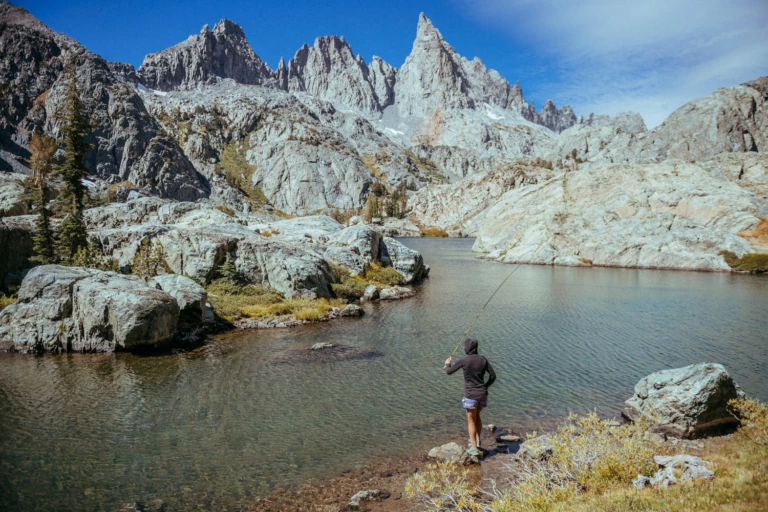
My last night in civilization I went to a bar and watched a YouTube video five times on “how to clean a trout.” The first fish I ate went pretty much how you are imagining it went. Photo: Ken Etzel
Mo, equipped with a master’s degree from Harvard, spent years in the Sierra waitressing at Red’s Meadow, the only restaurant on the John Muir Trail. After handing one too many burgers to backpackers who were quick to brag about how fast they had completed certain segments of the trail, Mo knew that when she finally hung up her apron and hiked it herself, she would not be one of those people. In fact, she would be the opposite: She would see how slowly she could hike the entire trail.
Some days she made it as few as three miles. She ran out of food, although she had brought along some mushrooms that both curbed her appetite and put a spring in her step and chants in her head. When she finally detoured off-trail to the Muir Trail Ranch resupply, which is located near the halfway point, the village was closing up for the season and the employees were emptying the cupboards. They made her a sandwich. She devoured it so quickly that they made her one for each hand, for free.
“Hey! Are you impressed with our tarp?” I asked the guy camping a few spots over. He said yes.
It was our first night and we’d hoped to be further along, camping in solitude at the banks of an obscure alpine lake on the High Route, past this crowded trail. Our crack of noon start time had blown this plan.
We had four nights and five days ahead of us, after which Mo would peel off and I would continue solo for six more days. The sun had been down for about 30 minutes, and we’d just polished off our entire trip’s ration of tequila. Blowing our load early like that was a rookie mistake, but in our defense Mo had snuck a bag of sour gummie worms into the bear bag pack to use as chasers, and those are the kind of surprises that can get a person feeling recklessly festive.
“A damn fine tarp,” I said, leaning back on a tree, pleased. I could see the tarp was not going to work, but I was buzzed enough to not cross that bridge tonight.
Five days later I said goodbye to Mo. I was going to miss her. But I still had Roper. His words would guide me. I limped north.
After leaving the main trail I went four days without seeing another soul. I had enough food for one more day on the trail. The next day would be a big day, and I would be out of food, but supposedly I would be able to cruise on easy terrain to Red’s Meadow, where Mo used to work and would be waiting to pick me up. If I got over the next two mountain passes before nightfall, the second of which Roper called “Shout-of-Relief Pass,” supposedly things would be a cakewalk compared to the last 10 days.
I had my head down, power hiking up a steep 4-mile section of trail. I was relishing in the luxury of not having to navigate, but also noticing that trails made my limp more pronounced. I heard a rustle and looked up to see a man. I screamed bloody murder. He screamed bloody murder.
“You’re the first person I’ve seen in four days!”
“You’re the first person I’ve seen in four days!”
We stared at each other for a few minutes, letting the adrenaline sink away. He broke the silence.
“Do you want to get high and eat chocolate-covered espresso beans?”
I really needed to get over those next passes and I knew it was going to be close, even if I somehow managed to navigate it correctly, which hadn’t happened once since I’d been left on my own with Roper. Plus, I didn’t really like marijuana.
“Absolutely.”
We got stoned as bullfrogs and ate his entire ration of candy. I was about to head out as the first drops of rain fell. He packed a second bowl. I set up the tarp, mainly to show off.
“Do you think I can get across the next two passes tonight if the rocks are wet,” I asked him. He was doing the High Route from South to North, and had just come from those passes.
“If you hustle, you can do it, but I wouldn’t call it safe. He says to stay high and contour between the passes, but that will be sketchy.”
“Yeah, He says that it will look impossible, but to go for it, and I will be able to find a route through all the cliffs. That’s why I’m concerned about all the rock getting wet.”
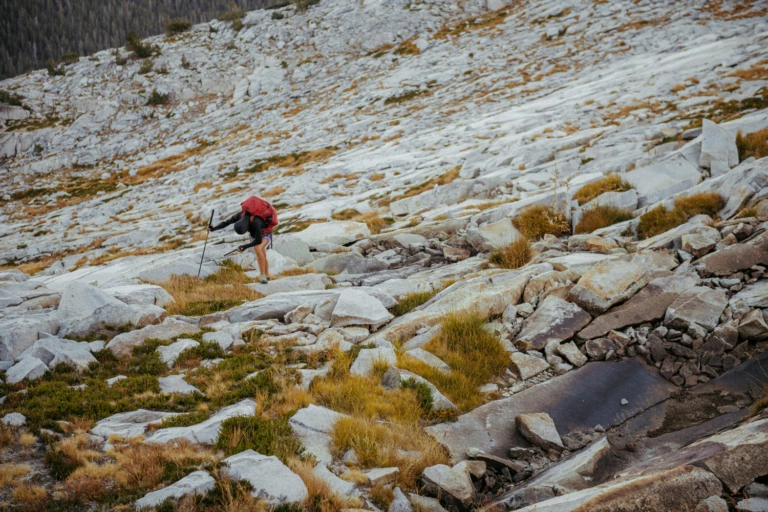
The mountains plunge into the earth and reach into the sky. Endurance is never a linear decline. Endurance is trusting that a high will follow your low. Endurance is wisdom, too. That your high is temporary. Photo: Ken Etzel
Normally I wouldn’t take drugs from strangers, but this guy wasn’t a complete stranger. We hadn’t learned each other’s names, but we’d both been swapping stories of trying to follow Roper’s directions. Plus we’d both been referring to Roper as He, which is how I knew this guy giving me chocolate and marijuana was a good person. We believed in the same god. “Just get to Shout-of-Relief Pass without getting yourself killed, and then it is smooth sailing.”
The rain stopped. I thanked him for the chocolate and the weed. I hadn’t had sugar in 11 days and I felt on top of the world. I wondered what I ever had against pot anyway. I made it over the two passes. Not without problems, but in the last days I’d learned to redefine what a problem was, just as I had learned to redefine what an impassable cliff was. Plus, I knew that when I got to Shout-of-Relief Pass, that all of the hard stuff was over, which kept my mood light. When I finally navigated all the cliffs, I crested the pass. I looked over and saw a gentle slope down to a green valley. I yelled, “Yabba Dabba Doobie!” I had made it. Just one more miserable night and one day of easy terrain left.
I cooked my last calories of couscous on top of the pass and, as the water boiled, I went to see what Roper had to say about the next section. That’s when I realized the book was gone.
I went from the happiest girl in the world to having the biggest sinking feeling ever. Bigger than feeling my bones snap inside my ski boot. Bigger than realizing I may never run a pain-free step again.
I was in the mountains, and I was completely and utterly alone. I’d lost Roper. I cursed the book for being so easy to lose. I knew that the spirit of the route was not to go fast in the mountains, it was to get lost in the mountains. I was fine with getting lost. I just wanted His words with me, unhelpful though they might be.
The old me would have chucked my couscous over the cliffs to the south in frustration. The new me chewed them silently. When I was finished, I packed my bag and then I started shouting. And shouting and shouting. All the shouts from the last year came out. If they weren’t shouts of relief in the beginning, they were shouts of relief by the end.
There wasn’t any boss of me now. I was going to put one foot in front of the other, in any damn direction that suited me.
I knew the carpet of rocks and wildflowers that unrolled beneath me eventually leveled out to a valley, and if I found willows they would lead me to a river that I would somehow find a way to cross, which would lead me to Red’s Meadow and Mo. I didn’t need someone else’s memory of a stag or directions to head for a mythical reddish cliff. It might take awhile longer than I or my stomach wanted. It definitely would take longer than my ego wanted. But it would all work out in the end. I could get lost on my own.
I thought about my favorite lyric by The Mars Volta: “You’ve got to lose it to find it.” Maybe that’s what the opposite of lonely meant.
Jenn Shelton is a Patagonia trail running ambassador.
This essay was featured in the September 2019 Patagonia Journal.
